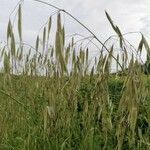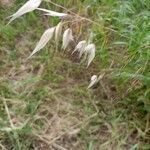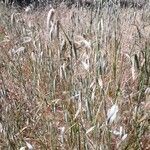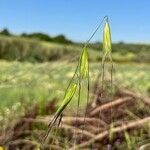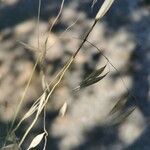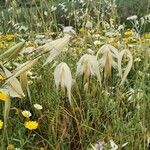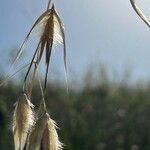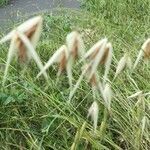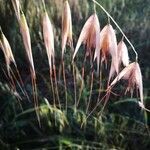Strong, rather stiff, erect green tufts to 150 cm, with heavy panicles. Leaf-sheath glabrous, or rarely with scattered soft hairs. Ligule 3-8 mm, truncate, or more tapered centrally, shortly denticulate, finely ciliate. Leaf-blade 15-45 cm × 3-15 mm, very finely scabrid on ribs, adaxially sometimes smooth, rarely with scattered hairs; margins minutely scabrid. Culm internodes glabrous. Panicle 20-40 cm, equilateral, lax; rachis smooth, branches few, widely spreading, filiform, scabrid. Spikelets often drooping; disarticulation above glumes; rachilla tough and continuous between florets. Glumes 9-11-nerved. Lemma elliptic-lanceolate, tough and hairy below level of awn insertion, greenish above and scabrid on nerves, narrowed to scarious bidentate apex; lower 1-2 lemmas awned; awn geniculate, column red-brown, twisted. Palea keels with 1-3 rows of cilia, interkeel usually minutely hairy above. Callus bordered by dense short hairs.
Annual; culms 30–120 cm. high, ascending from a geniculate or prostrate base, slender to rather stout, simple.. Leaf-blades up to 45 cm. long and 4–18 mm. wide, glabrous, scaberulous above and on the margins; ligules up to 6 mm. long.. Panicle nodding, up to 30 cm. long and 20 cm. wide, loose, with coarsely scaberulous branches.. Spikelets pendulous, 35–50 mm. long, 2–5-flowered, the rhachilla articulated at the base of the lowest floret only; glumes narrowly lanceolate, finely acute; lemmas 25–40 mm. long, densely bearded with hairs up to 7 mm. long around the horseshoe-shaped basal callus, loosely to densely hairy with long stiff hairs in the lower two-thirds, scabrid or shortly pubescent above, narrowed upwards and finely 2-toothed at the apex; awn 4–8 cm. long, geniculate, the column dark brown and pubescent.
Loosely tufted annual 500-1450 mm high; culms solitary. Leaf blade 200-500 x 4-15 mm. Spikelet 20-46 mm long; glumes as long as spikelet; lemma scabrid or shortly pubescent above; lobes to 0.5 mm long, awnless, 1-nerved; palea lanceolate, with 2 minutely hairy keels; callus present on lowest lemma only; anther 2.0-4.5 mm long. The distinguishing characters do not always occur together. Sometimes the rigid proximal hairs on lemmas are missing, but the short lobes are always present. Two subspecies are recognised namely subsp. sterilis (ligule 5-6 mm long, florets up to 5) and subsp. ludoviciana (ligule 3 mm long, florets up to 3).
A tall annual grass. It is green or bluish-green. The stems can be single or in groups. The leaves are narrow and about 15 mm wide. They can have some hairs on the edges. The ligule is 4-6 mm long. The flower is a loose panicle. The spikelets droop on slender stalks. The awn is slender and 30-60 mm long and twisted below a distinct elbow. The flowers fall as a unit and the spikelet does not break up.
Like A. fatua but spikelets to 46 mm long (versus 32 mm), lemma teeth to 0.5 mm long.
